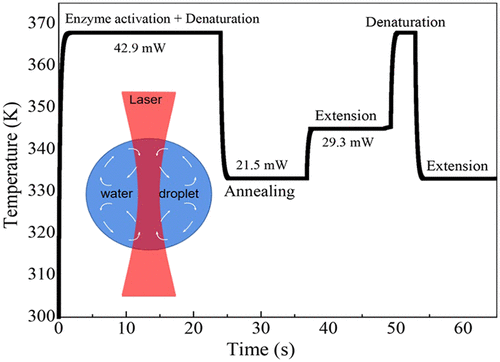当前位置:
X-MOL 学术
›
Ind. Eng. Chem. Res.
›
论文详情
Our official English website, www.x-mol.net, welcomes your
feedback! (Note: you will need to create a separate account there.)
Temperature Control of a Droplet Heated by an Infrared Laser for PCR Applications
Industrial & Engineering Chemistry Research ( IF 3.8 ) Pub Date : 2021-09-28 , DOI: 10.1021/acs.iecr.1c02979 Zhibin Wang 1, 2 , Xingguang Liang 1, 2 , Hongshi Su 1, 2 , Shiyi Li 1, 2 , Ying Chen 1, 2
Industrial & Engineering Chemistry Research ( IF 3.8 ) Pub Date : 2021-09-28 , DOI: 10.1021/acs.iecr.1c02979 Zhibin Wang 1, 2 , Xingguang Liang 1, 2 , Hongshi Su 1, 2 , Shiyi Li 1, 2 , Ying Chen 1, 2
Affiliation

|
Temperature control is one of the essential operations in droplet-based microfluidics. Light based on the photothermal effect is very suitable to heat a droplet because of noncontact and local heating. However, it is unable to predict the droplet temperature precisely. This paper reports an infrared laser to heat a droplet in a microchannel based on the photothermal effect for temperature control. The numerical method is applied to simulate the thermocapillary flow and heat transfer of this heating process. Particular attention is paid to the impact of laser beam size and input power on the droplet’s temperature distribution, heat transfer, and thermocapillary flow. The results show that increasing the laser power and decreasing the laser beam size increase the average temperature and thermocapillary flow due to the increase in the actual absorbed energy. The heat transfer coefficient of the droplet interface increases with the decrease of the laser beam size due to weakening of thermocapillary flow. It is also found that the nonuniform temperature coefficient reduces when the input power and the laser beam diameter increase, and the expression of the average temperature increase is obtained by considering the effects of the laser power and the laser beam diameter. With the obtained expression of the average temperature, a thermal cycle of polymerase chain reaction (PCR) amplification, a laboratory technique used to make multiple copies of a segment of deoxyribonucleic acid (DNA), can be successfully obtained. The results of this work will provide support for temperature control and applications, such as PCR amplification, in droplet-based microfluidics.
中文翻译:

用于 PCR 应用的红外激光加热液滴的温度控制
温度控制是基于液滴的微流体的基本操作之一。由于非接触和局部加热,基于光热效应的光非常适合加热液滴。然而,它无法准确预测液滴温度。本文报道了一种基于光热效应的红外激光加热微通道中的液滴以进行温度控制。应用数值方法模拟该加热过程的热毛细流动和传热。特别注意激光束尺寸和输入功率对液滴温度分布、传热和热毛细管流动的影响。结果表明,由于实际吸收能量的增加,增加激光功率和减小激光束尺寸会增加平均温度和热毛细管流量。由于热毛细流动减弱,液滴界面的传热系数随着激光束尺寸的减小而增加。还发现随着输入功率和激光束直径的增加,非均匀温度系数减小,通过考虑激光功率和激光束直径的影响得到平均温度升高的表达式。获得平均温度的表达,聚合酶链反应 (PCR) 扩增的热循环,这是一种实验室技术,用于制作脱氧核糖核酸 (DNA) 片段的多个拷贝,可以成功获得。这项工作的结果将为基于液滴的微流体中的温度控制和应用提供支持,例如 PCR 扩增。
更新日期:2021-10-06
中文翻译:

用于 PCR 应用的红外激光加热液滴的温度控制
温度控制是基于液滴的微流体的基本操作之一。由于非接触和局部加热,基于光热效应的光非常适合加热液滴。然而,它无法准确预测液滴温度。本文报道了一种基于光热效应的红外激光加热微通道中的液滴以进行温度控制。应用数值方法模拟该加热过程的热毛细流动和传热。特别注意激光束尺寸和输入功率对液滴温度分布、传热和热毛细管流动的影响。结果表明,由于实际吸收能量的增加,增加激光功率和减小激光束尺寸会增加平均温度和热毛细管流量。由于热毛细流动减弱,液滴界面的传热系数随着激光束尺寸的减小而增加。还发现随着输入功率和激光束直径的增加,非均匀温度系数减小,通过考虑激光功率和激光束直径的影响得到平均温度升高的表达式。获得平均温度的表达,聚合酶链反应 (PCR) 扩增的热循环,这是一种实验室技术,用于制作脱氧核糖核酸 (DNA) 片段的多个拷贝,可以成功获得。这项工作的结果将为基于液滴的微流体中的温度控制和应用提供支持,例如 PCR 扩增。











































 京公网安备 11010802027423号
京公网安备 11010802027423号